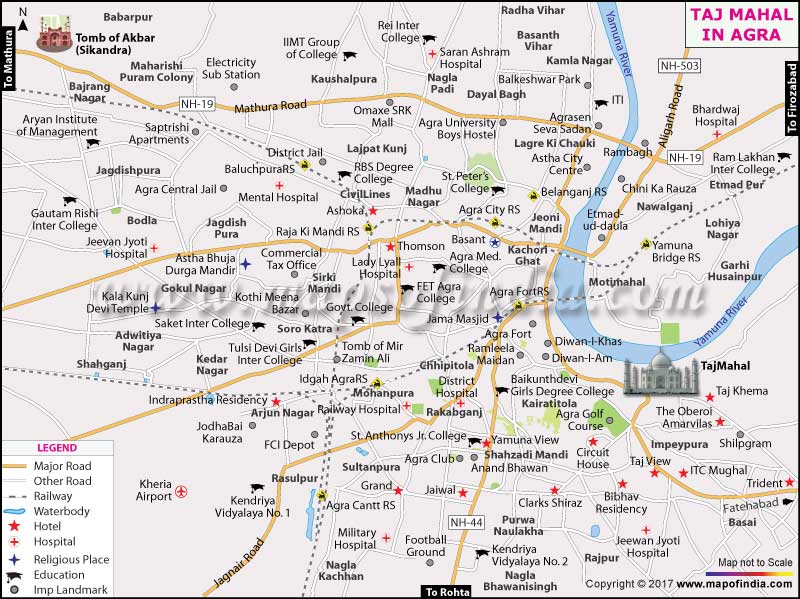Taj Mahal Map
In The New Seven Wonders Of The World list Taj Mahal, a mosque-mausoleum located in Indian city of Agra, takes a very important place. In spite of its Muslim origin this white marble necropolis became an actual symbol of India. Serious security measures are taken to protect it. There is a special.
Taj Mahal
India’s most emblematic monument, the Taj Mahal, is probably one of the best known structures in the world. Built in white marble by Emperor Shah Jahan, in memory of his wife Mumtaz after her death, the Taj Mahal is famous world over as the monument of love. A UNESCO World Heritage Site, the Taj Mahal is shrouded in myth and there have been many legends which have cropped up over the years. Here are interesting facts about this world famous monument:
Facts About the Taj Mahal
- The construction of the Taj Mahal began in 1632 and was completed in 1653. It took a total of twenty two years to complete the construction of this monument.
- The architecture of the Taj Mahal is a combination of Indian, Persian and Islamic styles of architecture.
- The name of the architect of the Taj Mahal is Ahmed Lahauri.
- The Taj Mahal was Shah Jahan’s imagination of Mumtaz’s home in paradise.
- Around 20,000 people worked day and night for twenty two years to complete construction of the Taj Mahal.
- The cost of construction of the Taj Mahal was around Rs.320 million.
- The Taj Mahal was constructed using the best quality marble from Rajasthan, Tibet, Afghanistan and China.
- At different times of the day the Taj Mahal appears to be in a different colour. Some believe that these changing colours depict the changing moods of a woman.
- The Taj Mahal is one of the wonders of the world and is also a UNESCO World Heritage Site.
- There was a popular myth that Shah Jahan was planning to construct a black Taj Mahal across the Yamuna, this is not true.
- Another popular myth around the Taj Mahal is that after the construction of the Taj Mahal, Shah Jahan cut off the hands of all the workers so that such a structure could not be built again. Fortunately, this is not true.
- The Taj Mahal has a mosque in its premises, which is why the Taj Mahal is closed on Fridays and only those going for customary prayers are permitted inside the Taj Mahal.
- Shah Jahan approached the Taj Mahal on a boat which would sail down the River Yamuna which ran behind the Taj Mahal.
- By the late 19th century, the Taj Mahal had been defaced by the British soldiers who chiseled out precious stones from the walls of the monument. At the end of the 19th century, British Viceroy, Lord Curzon, ordered a restoration of the monument and also gifted a large lamp which hangs in the interior chambers of the Taj Mahal.
- In 2000, an Indian writer P.N. Oak claimed that the Taj Mahal was actually a ShivTemple and filed a petition with the Supreme Court of India to excavate the site of the Taj to look for proof. His petition was rejected by the Supreme Court.
- In 2001, the UNESCO documented more than two million visitors to the Taj Mahal.
- India’s’ Nobel Laureate, Rabindranath Tagore, referred to the Taj Mahal as a “tear drop on the cheek of time”.
- Calligraphy on the tomb of Mumtaz identifies and praises her.
- The four minarets of the Taj Mahal have been constructed slightly outside of the plinth so that in case the minarets fell, they would fall away and not on the main structure.
- After his death, Shah Jahan was laid to rest in the Taj Mahal besides the tomb of his wife Mumtaz.
More about the Taj Mahal:

Related
Taj Mahal 360 View




